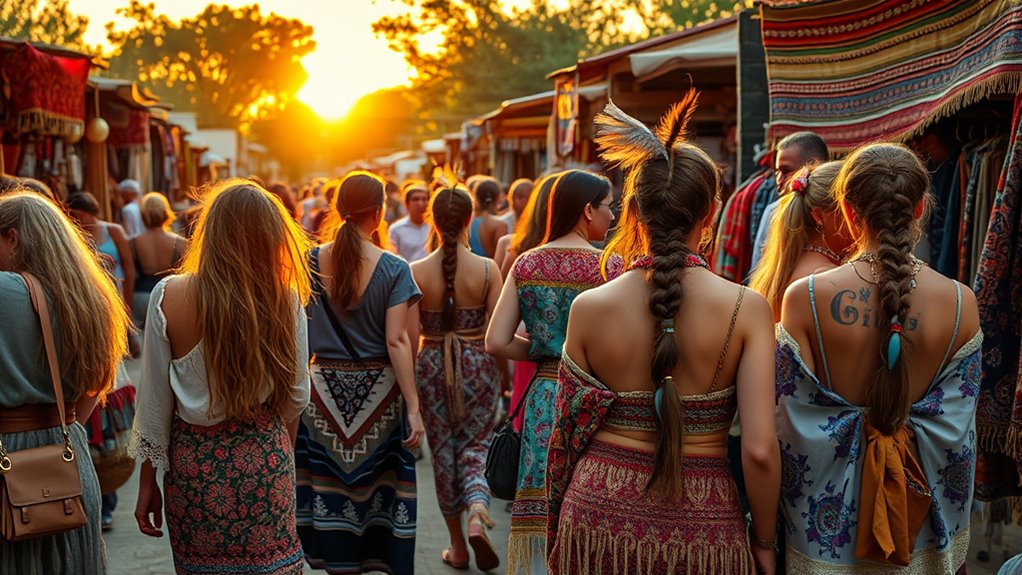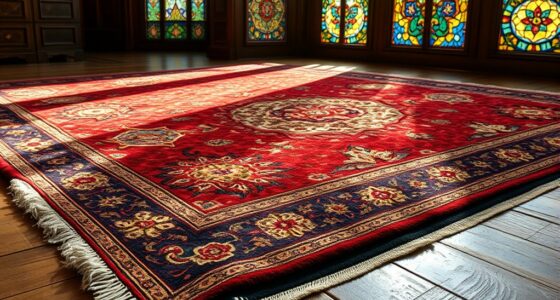The global spread of boho style started in the early 20th century among artists and writers seeking authentic self-expression, then gained popularity through celebrities and fashion icons. It expanded into interior design, blending cultural influences from Asia, Africa, and Latin America. Social media platforms amplified its reach, making boho a worldwide phenomenon. If you keep exploring, you’ll discover how social trends and cultural exchanges continue to shape this vibrant lifestyle worldwide.
Key Takeaways
- Boho originated in early 20th-century artistic circles rejecting societal norms and emphasizing cultural symbolism.
- Fashion icons and celebrities popularized boho elements, propelling its mainstream adoption worldwide.
- The style extended into interior design, blending global-inspired decor with sustainable, handcrafted elements.
- Cultural exchanges introduced rich textiles and motifs from Asia, Africa, and the Middle East, fostering diversity.
- Social media platforms amplified boho’s global reach through influencers, hashtags, and user-generated content.
The Origins of Boho: From Artistic Roots to Cultural Movement
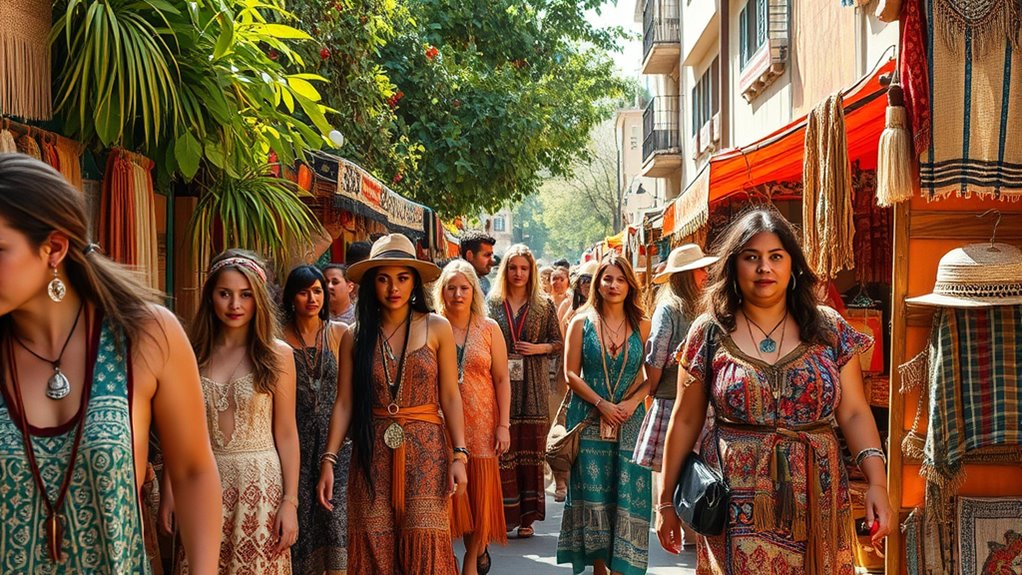
The origins of boho culture trace back to the early 20th century when artists and writers rejected traditional societal norms. You’ll find that this movement draws heavily on artistic inspiration, as creatives sought authentic self-expression beyond conventional standards. It was a time when cultural symbolism played a crucial role, with symbols from different traditions and eras influencing the aesthetic. The boho movement emerged as a blend of artistic freedom and cultural appreciation, emphasizing individuality, unconventional beauty, and a connection to diverse cultural roots. By rejecting mainstream fashion, those early adopters created a visual language that celebrated creativity and cultural stories. This foundation allowed boho to evolve into a broader cultural movement, resonating with people seeking authenticity and artistic expression. Incorporating elements like cultural symbolism into fashion and art helped solidify its unique identity and appeal.
The Role of Fashion Icons and Celebrities in Popularizing Boho
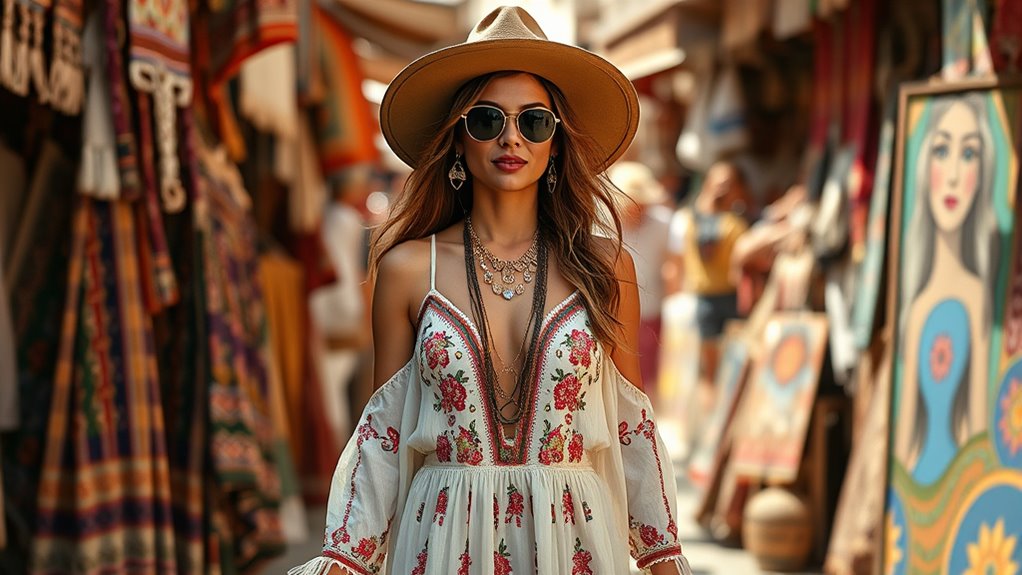
Fashion icons and celebrities have played a pivotal role in catapulting boho from niche aesthetic to mainstream trend. Their influence shapes fashion iconography, making boho elements like flowy dresses, layered jewelry, and earthy accessories instantly recognizable. When celebrities wear boho-inspired outfits on red carpets or in social media, it sparks widespread interest and adoption. Celebrity influence amplifies the trend’s reach, inspiring fans and fashion enthusiasts to emulate their style. High-profile endorsements and effortless looks establish boho as both glamorous and accessible. This celebrity-driven visibility helps normalize boho, integrating it into everyday fashion and reinforcing its status as a cultural movement. Additionally, the role of fashion icons and celebrities in promoting sustainable and eclectic styles further cements boho’s position in modern fashion. Ultimately, these fashion icons serve as powerful catalysts, transforming boho from a countercultural statement into a global style phenomenon.
Boho’s Journey Through Interior Design and Lifestyle Trends
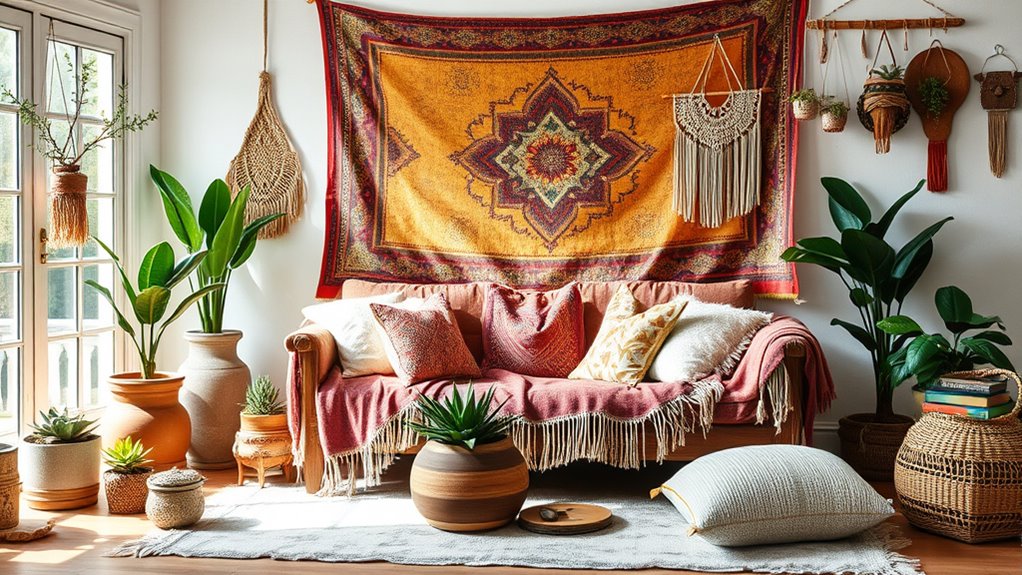
As boho style gained popularity in fashion, it naturally extended into interior design and lifestyle choices, transforming living spaces into reflections of its free-spirited, eclectic aesthetic. You begin to see this trend through various elements:
- Incorporating eco-friendly textiles like organic cotton and hemp for sustainable comfort.
- Showcasing artisanal craftsmanship via handcrafted furniture and decor pieces that emphasize uniqueness.
- Mixing vintage and global-inspired accessories to create a layered, worldly vibe.
- Emphasizing relaxed, cozy atmospheres that encourage personal expression. These choices foster a warm, inviting environment rooted in sustainability and authenticity. Boho’s journey into interior design emphasizes a conscious, artistic approach that celebrates individuality while honoring eco consciousness. It’s about creating spaces that are as vibrant and diverse as the lifestyle it embodies. The use of color accuracy in decor selection helps to enhance the overall aesthetic and mood of boho-inspired spaces.
Global Cultural Exchanges That Influenced Boho’s Evolution

Global cultural exchanges have played a pivotal role in shaping boho’s eclectic aesthetic, blending diverse traditions and artistic expressions from around the world. The textile trade, in particular, introduced rich fabrics, intricate patterns, and vibrant colors from Asia, Africa, and the Middle East, fueling boho’s love for layered textures. Cultural fusion became a hallmark, as artisans and designers combined elements like Moroccan rugs, Indian textiles, and Central American embroidery into a seamless, worldly style. These exchanges fostered an appreciation for craftsmanship and authenticity, making boho more than just a look—it became a celebration of global diversity. By borrowing and blending these influences, boho evolved into a truly international style that resonates with those seeking free-spirited, culturally rich aesthetics. Additionally, the compatibility of various cultural motifs helped create a harmonious and inclusive aesthetic that appeals to a worldwide audience.

The rise of social media platforms has dramatically expanded boho’s reach, allowing enthusiasts and influencers worldwide to share their eclectic styles instantly. You can now see boho fashion trending across Instagram, TikTok, and Pinterest, driven by influencer marketing and viral challenges. These elements amplify boho’s visibility and encourage participation, making it more accessible. To deepen your understanding, consider these key factors:
- Influencer collaborations spread boho styles to diverse audiences.
- Viral challenges showcase creative ways to wear boho pieces.
- Hashtags like #BohoVibes boost discoverability and community engagement.
- User-generated content fuels authentic connections and trend propagation.
- The digital age fosters rapid sharing and global influence, accelerating boho’s spread across different cultures and regions.
This digital synergy accelerates boho’s global evolution, transforming it from niche to mainstream almost overnight.
Frequently Asked Questions
How Did Boho Influence Music and Art Scenes Globally?
You see how boho influences music and art scenes worldwide by embracing hippie influence and promoting boho activism. It inspires artists and musicians to incorporate free-spirited, eclectic styles, fostering creativity and individuality. This movement encourages activism through artistic expression, highlighting social issues and cultural diversity. As a result, boho’s global impact creates vibrant, boundary-pushing scenes that celebrate peace, love, and self-expression across different cultures and artistic disciplines.
What Are the Regional Variations of Boho Style Worldwide?
You’ll notice regional variations of boho style everywhere you go. In Southern Europe, it blends with vibrant regional fashion and artisan craftsmanship, creating a colorful, relaxed vibe. In India, boho incorporates intricate textiles and handcrafted jewelry, reflecting local traditions. Meanwhile, in Australia, it emphasizes earthy tones and surf-inspired accessories. These regional twists make boho uniquely personal, celebrating local craftsmanship while maintaining its free-spirited essence.
How Has Boho Evolved Among Different Age Groups?
You see how boho style evolves across age groups through intergenerational trends and style adaptation. Younger people often mix boho with modern or edgy elements, creating a fresh, eclectic look. Older generations tend to preserve classic boho features like flowy fabrics and earthy tones. As time passes, each age group interprets boho differently, blending tradition with contemporary influences, allowing the style to stay relevant and versatile across generations.
What Role Do Local Artisans Play in Boho’s Global Spread?
Local artisans play a crucial role in boho’s global spread by preserving craftsmanship and fostering cultural exchange. As you explore boho styles worldwide, you’ll notice artisans bring authentic techniques and unique designs that enrich the movement. Their craftsmanship preserves traditional skills, making boho more diverse and genuine. This cultural exchange helps spread boho’s appeal, allowing you to embrace a style rooted in global artistry and heritage.
How Sustainable and Ethical Are Current Boho Fashion Practices?
You might think boho fashion is all style and no substance, but it’s a mixed bag. Some brands prioritize sustainable sourcing and ethical manufacturing, making sure their practices support fair wages and eco-friendly materials. However, others cut corners, leading to concerns about environmental impact and worker rights. So, stay vigilant and choose brands committed to real sustainability, because not all that glitters is genuinely ethical.
Conclusion
Just as the Renaissance revived art and ideas from the past, boho’s journey reflects a continuous blending of cultures and eras. Through social media’s lens, you see it flourish—an echo of the hippie movement and global exchanges shaping its evolution. As you embrace boho’s free spirit, remember it’s more than style; it’s a tapestry woven from history, creativity, and connection, reminding you that, like the phoenix, true influence rises anew from the ashes of tradition.

